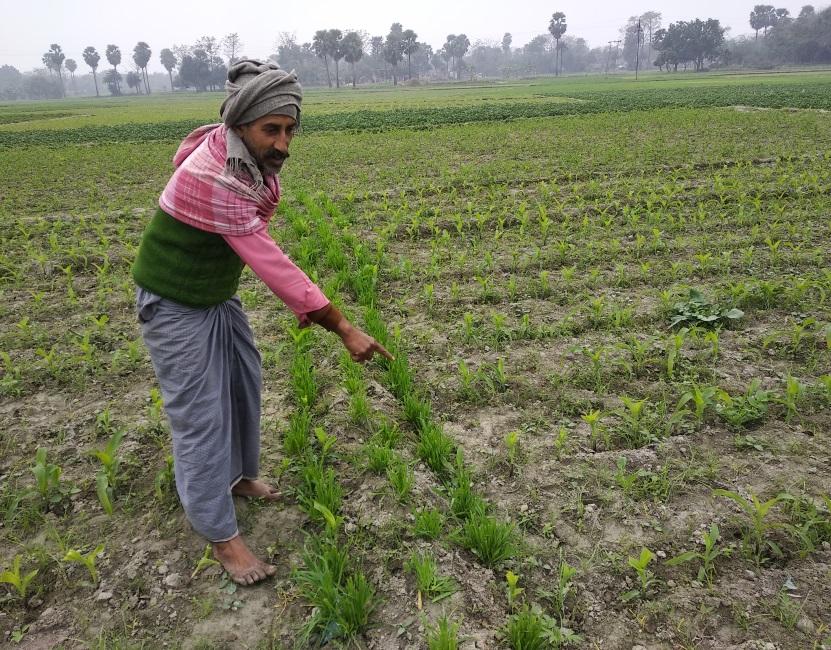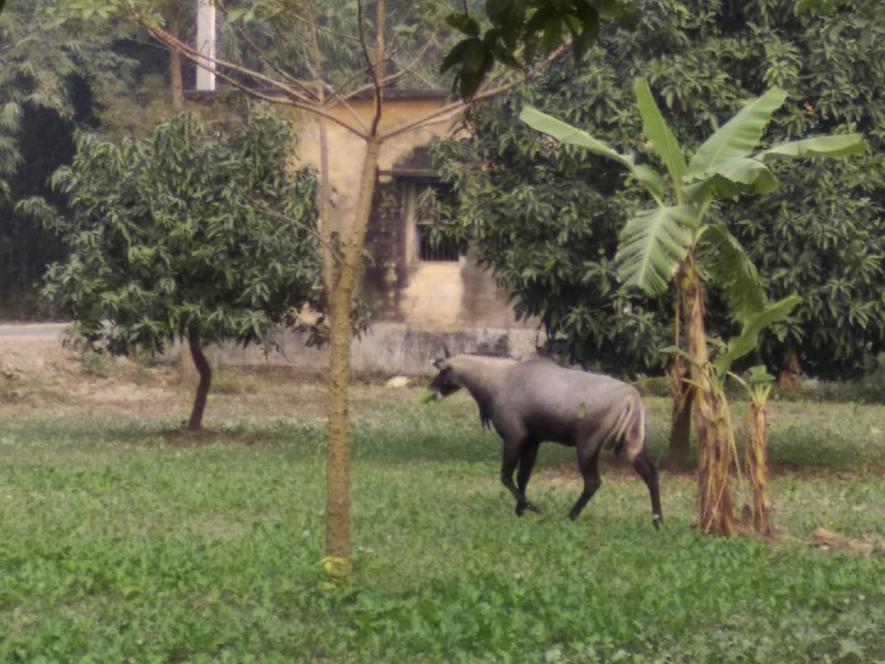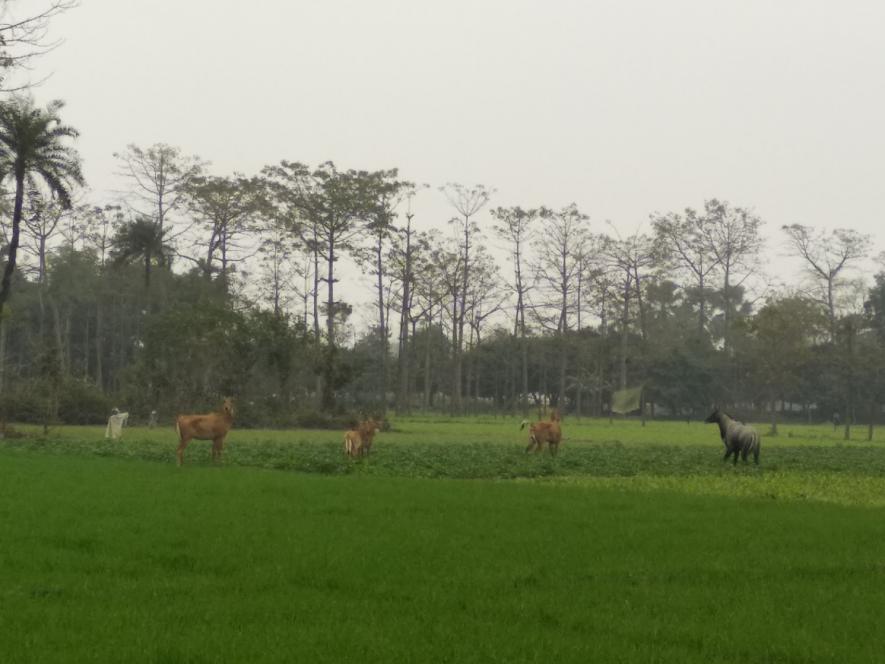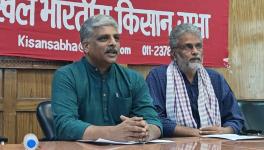Farmers in Bihar Cry Crop Devastation by Asian Antelope, Threaten Protest

Ram Ekval Rai shows destruction of maize plants by nilgai.
Ram Ekval Rai, who has been growing maize in a village in Muzaffarpur district of Bihar is a troubled man. The fruits of his sweat and toil lie damaged in front of this eyes.
“An acre of my maize fields are being destroyed by nilgai (commonly used term by rural population for Asian antelope or blue bull). Be it morning, day or night they fearlessly roam around in villages, Ram Ekval told Newsclick.
He says every year the rampage of farm fields by these animals had become a nightmare that farmers are being unable to handle.
“At times, we remain awake at night with torch and stick to shoo them away when they enter our fields,” he added.
Similarly, Babu Lal Rai of the same village, has a similar story. He said be it any crop, the nilgai destroys them.
“Keeping aside our daily work that gives us income, we find it hard to run behind these wild animals, which often also attack people who come in their way. The situation has compelled us to keep stocks of firecrackers to frighten these rogue animals when they raid our fields. They come in herds of 10-20 and stamp on the crops, not even sparing the trees,” said Babu Lal.
The former village head or mukhiya of Kanti block in the village, Deep Narayan Singh, even termed the devastation by nilgai as “terror”, adding that the farmers are facing economic hardship at the time of harvest as quantity of crop has come down drastically. Though the state government provides compensation for crop damage, the complex procedure makes availing it tough for farmers, he adds.
To highlight their problems, a delegation of farmers, led by former minister Ajit Kumar, met the Muzaffarpur administration recently and appealed to them to take steps to control the menace or, if need be, even “kill rogue animals”. The farmers accused the “laxity” of the forest officials concerned in taking action, and have now threatened to stage a protest if the “inaction” continues.
It may be noted that nilgai was officially declared by the Bihar government as ‘vermin’ in 2015 after its plea was accepted by the Central government after a series of complaints from various districts of the state about these antelopes ravaging farmlands. Apart from Bihar, farmers of Maharashtra, Madhya Pradesh, Uttarakhand have also urged their respective governments to act against this growing menace that’s damaging their crops.

Nilgais seen running on farmlands over standing crop.
Farmers across districts of North Bihar have been constantly complaining of crop destruction by nilgais, but its solution seems to be a tough challenge both for the government and the administration. The Bihar government has started the process of countering the damage done to crops by the blue bull by ordering to kill them. This would reportedly be done by engaging professional shooters, especially in districts where the damage is colossal.
Sources in Muzaffarpur district administration told Newsclick that the decision to kill the wild animal had been taken, but unavailability of professional shooters was a hurdle.
A total of 1,500 farmers have registered complaints only from Tirhut region of the state. Three shooters have reportedly filed applications for this job, but were rejected as they did not qualify on the parameter of having their own rifles, said sources, adding that bullets would be supplied by the government as also an open headed vehicle.
An official of the state department of environment, forest, and climate change, on condition of anonymity, said that Hyderabadi sharpshooter Nawab Shafath Ali Khan had been approached by the Bihar government but a response from him was awaited. Khan is a shooter whose services in past have been availed by forest departments of different states to train their personnel in field of shooting rogue and wild animals. It also learnt that the forest department has notified Rs. 2,000 as the amount to kill one nilgai.
In conversation with Newsclick, Muzaffarpur District Forest Officer (DFO) Sunil Kumar Karn said the district “comes under my responsibility. On December 26, we decided to cull 500 nilgais in the first phase.” However. according to the government’s order, at the DFO level, only 100 of them can be killed and 500 at the level of conservator, but as complaint volume of farmers was high, the number was higher.

A nilgai seen eating leaves of banana plant in a village of Bihar
The first time the Bihar government allowed culling of nilgai was in 2007 when nearly 31 districts out of 38 faced heavy crop losses. The government had empowered the Collectors and Sub-Divisional Magistrates to issue the ‘shoot orders’ under Section 11 (A) of the Wildlife Protection Act, 1972.
Nilgais come under Schedule 3 of the Act and the state government can issue orders to eliminate them when they become a threat to human life and property. Again, in 2016, Bihar Chief Minister Nitish Kumar passed orders to kill nilgais to control their rising numbers and prevent rampant crop damage.
Other state governments where the farming community faces crop loss due to animals have also taken necessary action against nilgais and wild pigs. For example, in 2015, firearm licence-holders in Uttar Pradesh had been engaged to kill these wild animals to stop devastation of farmlands. The Rajasthan government also has a proposal to allow shooting of nilgais with non-lethal darts to inhibit fertilisation and check their increasing population.
The Asian antelopes have been known to wreak havoc on crops, particularly in the districts of Muzaffarpur, Bhojpur, Vaishali, Samastipur and Champaran. According to Environmental Impact Assessment (Draft) Bihar 2016, nilgai is endemic to the Indian sub-continent and has been categorised as “Least Concern” by the International Union for Conservation of Nature.

Nilgais in herds in a farmfield
Reiterating an incident of brutality against it (in Vaishali district last year, on instruction of a legislator, a nilgai was buried alive), Rameshwar Ojha of Lalganj in Vaishali district, said there should be a rethink on the reason behind crop destruction caused by nilgai. He said the rapid erosion of forest cover due to unplanned urbanisation has pushed these animals to shift from natural forest cover to farmland. “If we snatch away a living creature’s habitat, then sole choice for them is to search for an alternative,” he added.
This ‘burial’ incident had created a lot of controversy after which state government had go on backfoot and ordered a probe.
Environment experts also believe that the bifurcation of Bihar into Jharkhand as a new state had led to a lot of forests going over to Jharkhand. So, the absence of forests was one reason for nilgais to roam around for food and shelter.
The culling of nilgai has been termed as “brutality” by social activists and environmentalists. Shivanshu K. Srivastava, a social activist, wrote that “The culling of nilgais (blue bulls) in Bihar in July 2016 was so deplorable that it doesn't need any justification…. the farmers can either opt for fencing around the farmlands or if it's unaffordable, then the government can give ordinances to relocate them to the forests.”
The writer is an independent researcher on sub-altern issues in Bihar and revolutionary movements in India.
Get the latest reports & analysis with people's perspective on Protests, movements & deep analytical videos, discussions of the current affairs in your Telegram app. Subscribe to NewsClick's Telegram channel & get Real-Time updates on stories, as they get published on our website.
























